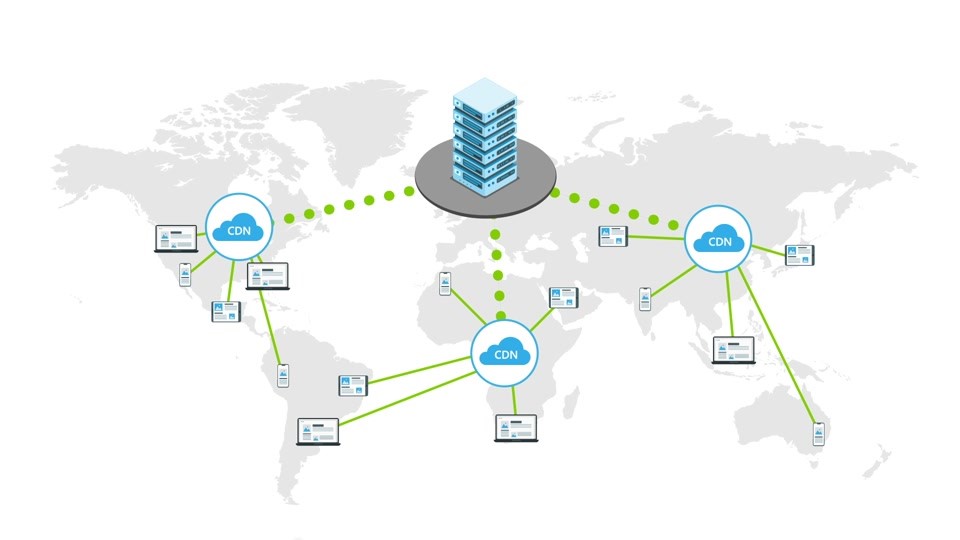[column 10 cm 12]
What is a CDN? The exact answer to this question, which is one of the basic concepts of the Internet, is of great importance. Literally, CDN stands for Content Delivery Network and means “content distribution network”; but this is just a simple meaning and to understand it more deeply, we need to become more familiar with the concepts of this field. For this reason, in this article from the Pars Pack Blog CDN training, we intend to explain this concept and also answer other important questions: What is a content distribution network? What are the types of CDN? What are the uses and benefits of using a CDN? So stay with us until the end.
What is a content distribution network or CDN?
A content distribution network (CDN) is a collection of servers distributed and connected to each other in different parts of the world. If you want to know what the most important or even the only function of a CDN is, it is responsible for displaying website content from the location closest to the user. This can have a significant impact on the speed of your website. Let’s explain this with a simple example.
If the website’s servers are located in Tehran, people in Mazandaran will access the content faster than people living in Ahvaz or Zahedan! Therefore, the further away customers are from a company’s data center, the slower the website or app will load, resulting in an inconsistent and frustrating user experience. In general, slow loading speeds create an unpleasant experience because:
25% of users abandon a website that takes more than four seconds to load.
74% of users abandon a website that takes more than five seconds to load on mobile.
46% of users never return to slow websites.
Most of the above problems can be easily solved by purchasing a content delivery network (CDN). Therefore, by using a CDN, your website performance will increase significantly by reducing the time it takes to deliver the content the user wants. It is interesting to know that today’s big sites like Google and Amazon also use CDNs.
How does a content delivery network work?
Now that we understand what a content delivery network is, we need to know a few things about how it works. Imagine you are in Tehran and you request an image from a server in a European country that is 5300 km away. It usually takes about 300 milliseconds to send a request and receive a response. If you request the same image from a server in Iran that is about 50 km away from Tehran, it will take about 10 milliseconds to send the request and receive the response, which is actually about 30 times better than the first case. But since we’re talking about milliseconds, this difference may seem insignificant.
However, when you consider that a typical web page contains over 2MB of information with 30 simultaneous requests, the difference becomes huge, and since each request may go to the server and back multiple times, these milliseconds add up to a lot of time and slow down the website.
Storing or Caching Content on a CDN
You can store your content on a content delivery network (CDN) so that it can be delivered to end users via edge servers much faster than it would be sent from the source. If you use a content delivery network (CDN), this means that if someone tries to access your content from your website or mobile app, that person’s request for the content only has to go to a nearby access point and doesn’t have to travel long distances to the company’s main servers.
CDNs are used to increase the speed and security of websites. By storing and caching website content in the cache of edge servers, this service tries to deliver requested content to users from the closest server. CDN significantly increases the speed of content delivery. Increased website performance, stability, and security, and reduced traffic load on the host server are some of the benefits of using a CDN.
How do CDNs work?
To prevent user frustration due to slow service, CDNs deliver content closer to the user to reduce latency and improve the user experience. In theory, this sounds simple and interesting, but in practice, there are some technical challenges. As a first step to reducing latency for each specific user, a CDN must have a content storage server and cache close to it, but unfortunately, it is not possible to have a cache close to every potential Internet user. Instead, they organize warehouses into points of presence and distribute them across broad geographic regions (Europe, the United States, Asia, etc.) and then place them in major population centers within those regions.
Next, based on user requests, the CDN must route them to the nearest point of access (POP), which most CDNs do using a technology called GeoIP. A GeoIP can be thought of as a large lookup table that maps IP addresses to geographic regions (country, city, etc.), and when a request is processed, the CDN references the table and routes the user’s traffic to the nearest available server.
What is a CDN used for?
So far, we’ve covered what a CDN is and its general uses. Now, let’s talk about using a more specialized CDN.
Why use a content delivery network?
The main purpose of a CDN is to deliver the user’s requested content through a network of servers in a secure and efficient manner.
These networks improve content security, performance, and accessibility. Other uses of CDNs include collecting and analyzing user data and tracking network traffic.
Who can use a CDN?
CDN?
A CDN can be useful for website or mobile app owners who are likely to have more than one user making requests to the system at the same time. This is especially important for large, complex websites with users spread across the globe, and websites or mobile apps with dynamic content. Some of the benefits that a CDN provides to a website include:
Faster loading times for web and mobile users
Scalable during times of heavy traffic
Reduces the risk of traffic spikes at the origin and ensures website stability.
Lower infrastructure costs due to reduced traffic
Better site performance
CDNs also offer several specific benefits for different types of businesses and organizations, some of which we will mention below.
✓ E-commerce
A CDN helps e-commerce sites deliver content faster and more efficiently, even during peak times, such as Black Friday and the holidays.
✓ Government
Large, content-rich websites can deliver critical information to citizens faster and more efficiently by using a content delivery network (CDN).
✓ Finance, Investments, and Assets
CDNs provide a fast, secure, and reliable infrastructure for banking institutions to deliver sensitive data to consumers and analysts.
✓ Media/Publishing
Media sites need to deliver up-to-date and up-to-date information, and a CDN can help these companies keep their headlines and homepages up-to-date by publishing news in real-time and deleting or archiving it when the data becomes outdated.
✓ Mobile Apps
A CDN delivers dynamic, location-based content to mobile apps, reducing load times and increasing responsiveness.
✓ Technology and Software as a Service (SaaS)
Content delivery networks help technical websites respond to billions of user requests daily without performance degradation.
What are the benefits of a CDN?
The benefits of a CDN are so numerous that I could write a detailed article about them. However, if you want to know what the benefits of using a CDN are, here are three of its most important benefits.
1. Increase Site Performance
CDNs reduce the loading time of website pages or web applications, which in turn reduces the bounce rate of users from the website and, as a result, has a significant impact on the sales of products or services.
2. Increase website availability and uptime
Since using a CDN, your website is accessible through multiple servers, the availability and, consequently, the uptime of your website will be much higher than when you do not use a CDN.
3. Save on resources and costs
Another advantage of CDN is saving on server costs. Using a CDN, less bandwidth is consumed from your server, which can save you resources and costs.
Types of CDN
Now that we understand what a CDN is, we need to know the types of CDNs. Although there are different categories of CDNs, we will review the most important ones below.
1. Peer-to-Peer Content Distribution Network
This CDN technology uses the P2P (peer-to-peer) protocol that µTorrent users are somewhat familiar with. In addition to µTorrent, many other large companies, such as AT&T, use this protocol to distribute web content.
In this protocol, there is no caching involved and, in fact, end users are part of a CDN network and load web content at the same time as they download or access a live streaming system. Since this protocol uses less resources and hardware, some CDN providers such as PPS.tv, Freecast, and Peercast offer free P2P services to their customers.
2. CDN Content Distribution Network
In this method, origin servers manually or automatically push web content directly to CDN servers. In this way, the content will be stored on the CDN servers. The main concept of Push CDN is that web administrators are responsible for pushing content to CDN servers. The content they pay for is the content that the system delivers to visitors when requested.
3. Content Distribution Network (CDN)
This system works in the exact opposite way to Push CDN; this means that these content networks are responsible for receiving the content that is served to the end user after receiving the request. In a Pull CDN system, webmasters are allowed to stay on the main servers; but they will rewrite the URL to point to the CDN servers.
Pars Pack Content Distribution Network Service Provider
Pars Pack CDN will have a significant impact on improving the speed and SEO results of your site and will also help maintain the security of your website. In this regard, we should add that depending on the plans offered, SSL is automatically installed on your website and in some of the plans offered, you can keep your website safe from issues such as DDoS. In addition, Pars Pack’s more advanced antivirus plans include protection against Trojans and malware. Another security feature of Pars Pack’s CDN is the use of WAF technology, which first checks all requests with a security firewall, thus preventing the site from being hacked.
People who have customers and visitors from Iran
Doctor, it is better to use local content distribution services that have contracts within Iran, which increases the speed of serving their users. Pars Pack CDN service has 15 local nodes and 15 nodes in Europe, which has special conditions with the best distribution and facilities to improve the speed and security of your online business.
Conclusion
What is a CDN? CDN is a tool that helps increase website security. In general, to reduce the possibility of information leakage, you should consider script security first and foremost.
Achieving success. The stronger your security layers are, the less likely you are to encounter attacks in the future. In this article from Pars Pack blog hosting services, we have outlined several key ideas behind content delivery network services, introduced this network, and explained how it works, its types, applications, and benefits. Finally, we suggest you explore the different options and try to understand how the CDN of your choice can improve the performance of your website.
[/column] [column 2 cm 12]
[/column]



 فارسی
فارسی العربية
العربية Français
Français Deutsch
Deutsch Русский
Русский 繁體中文
繁體中文